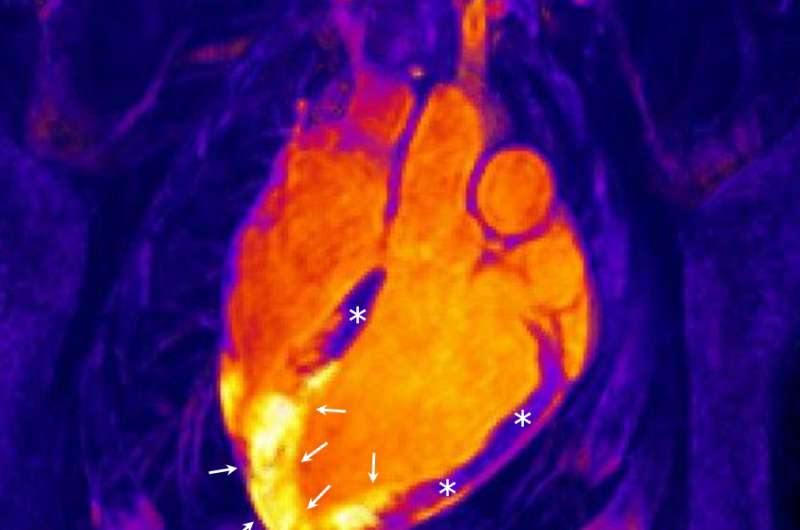Dramatic new studies into inflammation in the infarcted heart could lead to changes in therapy

A medical research collaborative has demonstrated that the response of the human heart to an infarction is very different than previously thought. The study, led by cardiologist Borja Ibáñez and published as two independent articles in the leading journals Circulation and Circulation Research overturns the established view that an infarction is followed by progressive repair of the myocardium.
For many years, scientists have assumed that a heart attack is followed immediately by an inflammatory response featuring increases in water content and cellular infiltration, and that this response remains stable for at least one before progressively dissipating. Two years ago, the research team behind the new studies published a series of animal studies that challenged this view, but the most important challenge remained: to validate the new findings in human patients. The new studies used MRI technology to demonstrate that the human heart produces two well-differentiated edematous reactions occurring at distinct times after an infarction. These results have immediate clinical implications for ongoing clinical trials and could form the basis of future studies focused on the specific modulation of each of these independent edematous phases.
The project came out of research started more than 10 years ago at Mount Sinai Hospital in New York, directed by renowned cardiologist Valentín Fuster, an author on both of the new CNIC-led studies. Rodrigo Fernández-Jiménez, first author on both studies, said, "Surprisingly, we still know very little about how the myocardium reacts to an infarction, and it is only through the use of MRI, which allows noninvasive, millimeter-resolution mapping of tissue composition that we are beginning to understand many of its mysteries."
The bimodal postinfarction inflammatory reaction was first demonstrated in animals in 2015, but this left the much more difficult challenge of demonstrating that the same phenomenon occurs in humans. Undertaking such a study required a special setup that would allow detailed MRI studies to be carried out immediately after the re-establishment of blood flow through the blocked coronary artery in heart attack patients. This requires highly complex technology and is therefore possible in only a handful of centers.
One center with the technology and expertise to carry out this type of study is the university hospital in Salamanca. Chief cardiologist Pedro Luis Sánchez said, "We've been able to carry out this work thanks to the enthusiasm and commitment of everyone in the service. Heart attacks can happen at any time of day or night, and for this study, we needed to do the first MRI scan within three hours of fitting a stent in the blocked artery to re-establish blood flow. Patients are particularly vulnerable during this period, so in addition to the expert MRI specialists, we also needed a full clinical support team on hand to provide continuous care during the examination period."
The study is the first in the world to study heart attack patients via MRI so soon after the re-establishment of blood flow. In addition to studies in patients, the team has also extended the investigation to infarction in pigs, the experimental model most similar to humans. The unique translational research infrastructure at the CNIC includes identical imaging equipment for human and animal studies, allowing the team to demonstrate that treatments during an infarction can change the composition of the cardiac muscle during the first hours after reperfusion, resulting in a much more rapid recovery of the heart. In the words of Dr. Fernández-Jiménez, "MRI provides an extraordinary ability to noninvasively visualize events occurring after an infarction in real time, including inflammation, tissue volume expansion, hemorrhage, and obstruction of the microcirculation."
According to Dr. Ibáñez, the discovery of the bimodal inflammatory response in the human heart "forces us to think about the best timing for MRI scans used in clinical trials to quantify irreversible injury and to monitor the effectiveness of interventions to reduce this injury. Until now, this question was not considered important, and cardiac imaging studies have been conducted on any day in the postinfarction period. The new findings show that the optimal time for these scans is between postinfarction days four and seven, when the second inflammatory/edematous wave is prominent and affects the entire region that was shut off from the blood supply during the infarction."
This research project was possible thanks to the unique research infrastructure at the CNIC, which boasts imaging analysis equipment unrivaled anywhere in Europe, all at the service of leading international research groups. CNIC General Director Dr. Fuster said, "We invested in the best imaging technology in order to study biological and clinical processes from a totally new perspective." This unique technology is allowing translational researchers to address clinically relevant questions in a way that greatly accelerates the pace of research.
Another essential element of this research endeavor is the scientific collaboration between the CNIC and technology partner Philips Iberia. Physicist Javier Sánchez-González, a Philips researcher embedded at the CNIC, leads the technological development of these cardiac imaging projects, and his input is essential for transferring the initial findings from the CNIC to collaborating hospitals, so that the new algorithms can be tested in a clinical environment. Recently, the consortium formed by the CNIC, the FJD and Salamanca university hospitals, and Philips was awarded funding under the Carlos III Institute of Health's technology development program for the development of new three-dimensional cardiac resonance sequences.
More information: Rodrigo Fernández-Jiménez et al, Dynamic Edematous Response of the Human Heart to Myocardial Infarction: Implications for Assessing Myocardial Area at Risk and Salvage, Circulation (2017). DOI: 10.1161/CIRCULATIONAHA.116.025582

















